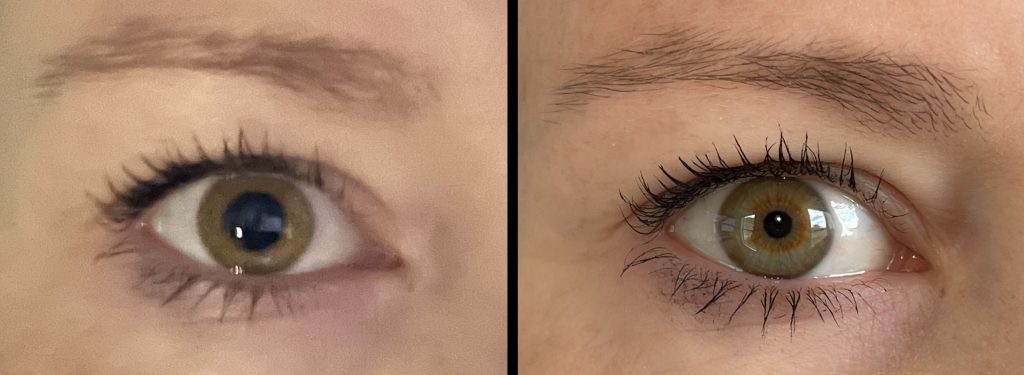I used to have perfect vision: In my 20s I passed the rigorous Air Force optometry screening for pilot candidates. Now in my late 40s I have developed the inevitable presbyopia that comes with age: The lenses of my eyes have lost so much flexibility that I can’t focus on things as close as I used to. I can no longer read fine print that used to be easily legible. In dimly lit restaurants I struggle to read menus. Both of these can be solved with reading glasses, but I don’t routinely carry those. So I often rely on two tricks to compensate.
The first trick is to increase light. I can read almost anything in direct sunlight.. In a restaurant I pull out my phone and shine its illuminator on the menu. Why does adding light sharpen text that is otherwise blurry or out of focus? There are some interesting optics at work.
The following image contrasts two photos of the same human eye. The photo on the left was taken in a dimly lit room, which has encouraged the pupil to open to let in more light. The photo on the right was taken with daylight coming through a window: The extra light causes the pupil to close.

The wider the aperture (which in an eye is the pupil), the greater the focal range of a lens. In sunlight our pupils are as small as they can get, which gives us the maximum focal range. With presbyopia, my lenses can’t accommodate (i.e., change shape to shift focus) as close as they used to, but they can still go far enough that the added focal range from a small pupil brings close objects into focus. The same physics applies to camera lenses, as I demonstrate in the following image:

I put a pill bottle closer than the minimum focal distance of this camera lens. A photo taken with the lens aperture wide open (f/1.7) shows that the lens can’t bring the text into focus. Keeping the lens at the same distance and focus setting, but stopping the aperture down almost as small as it gets (f/22) increases the focal range and brings the text into focus. (The photo of the lens in the second row actually shows the diaphragm at f/2.8 because at f/1.7 it can’t be seen.)
Bright light causes our pupil to contract naturally. The second trick is to create an artificially small aperture. You can do this by putting a pinhole lens close to your eye. I do this by closing my fingers and looking through the tiny opening left between two of them at the joint:

The aperture trick can only compensate so much: With too little light the subject may be in focus but the contrast might be too low to read it. In the camera example: The exposure with the wide aperture was made in 1/640 of a second, but it took 1/4 second to get an adequate exposure at the minimum aperture (holding all other settings constant).
I have a related post on my substack: Why I Dislike Dark Mode.